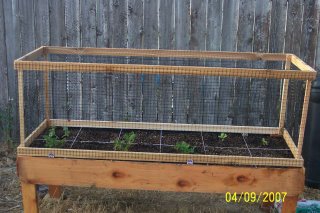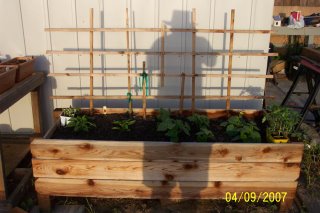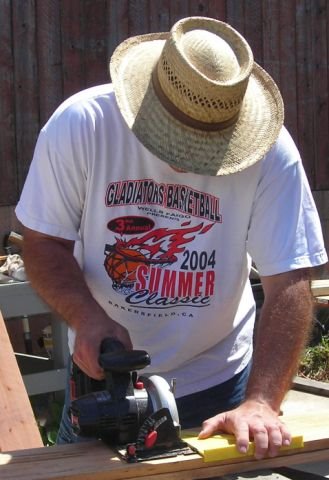The Plants Are In
The rain that had me so concerned on Friday turned out to not be such a big deal. It rained a little bit in the very early morning on Sunday, that's it.
It's been a very very busy weekend. When I first planted in my SFG beds about a week ago I put in a few transplants and also planted a few cantaloupe and snap pea seeds. When I removed the compost to remix (see previous post) I couldn't find most of the seeds. I then found the outer shell of the cantaloupe seeds among the young vines of the watermelon plant. The birds had dug up the seeds and ate them. A closer inspection of the young plants indicated that the birds had been nibbling at the leaves. Mel Bartholomew has a solution for this problem. In his book he describes how to make a chicken wire type of dome that can go over the planters. The dome will keep pests, like birds, out of the garden. The chicken wire dome can also be used as the framework for other garden structures. For instance, plastic sheeting can be draped over the frame to make a temporary green house or to protect the plants from harsh weather. I did something similar. I framed up a 6'X2'X2" box using redwood fence boards that I cut to size and connected using brads (Note to self: "Be sure to change the 2" brads to 1" brads when connecting thin boards .. also, find out when you last had a tetanus shot). Instead of chicken wire I used a stiff plastic garden mesh that I stapled to the frame.
Since I'm so far behind in planting this year I decided to plant with transplants rather than sew seeds. My wife and I went to OSH and purchased a few vegetable and flower transplants to put in the garden.
The planters are divided in square foot segments by the use of a string grid. In each square foot grid I can plant between 1 and 16 plants, depending on what exactly I am planting. For instance, as per Mel's book, zucchini can be planted 2 per square foot, broccoli is 1 plant per square foot, lettuce is 4 per square foot. Some plants require more than one square foot, such as watermelon and strawberries. Plants that require trellising are located in the back, on the North side of the planter (I will be building trellises next weekend). All vining plants are trellised, even watermelon and cantaloupe. For ease of reading I have divided my planters into front and back rows and numbered each square foot grid sequentially from left to right; so, the square in the back left corner is B1, the square in the front right corner is F6.
Planter #1 (the wife's):
 The only thing planted in #1 so far is a zucchini in B1. In the picture above you can see two of the screen frames that I built. These two screen frames are only 1" wide so they are modular, I can use 1 or 2 depending on what's been planted and whether or not I need the entire bed protected. In the picture I have one frame lengthwise across the back six squares.
The only thing planted in #1 so far is a zucchini in B1. In the picture above you can see two of the screen frames that I built. These two screen frames are only 1" wide so they are modular, I can use 1 or 2 depending on what's been planted and whether or not I need the entire bed protected. In the picture I have one frame lengthwise across the back six squares.
Planter #2
 B1 & B2 = Watermelon; B3 & B4 = Sugar Snap Peas (9 per sq. ft) .. I didn't buy enough so I only have 6 per sq. ft.; B5 & B6 = Watermelon
B1 & B2 = Watermelon; B3 & B4 = Sugar Snap Peas (9 per sq. ft) .. I didn't buy enough so I only have 6 per sq. ft.; B5 & B6 = Watermelon
F1 = Empty (future lettuce); F2 = Lettuce (4 per sq. ft.); F3 = Empty (future lettuce)
F4, F5 & F6 are empty. I intend to plant spinach here (9 per sq. ft.)
Planter #3
 B1 & B2 = Watermelon; B3 & B4 = Empty; B5 = Cantaloupe; B6 = Cantaloupe
B1 & B2 = Watermelon; B3 & B4 = Empty; B5 = Cantaloupe; B6 = Cantaloupe
F1, F2, F3, F4 = Strawberries (3 per 4 sq. feet); F5 & F6 = Empty (Dahlia's are planned)
This is the elevated bed I built last year. It's filled with a traditional potting soil growing medium (and worms .. see the "Got Compost?" post). It will be interesting to see how this bed does compared to the SFG beds (These plants have been in for about a month. I've used a liquid fertilizer; I'm just now starting to see significant growth. From L to R: Green bell pepper, red bell pepper, green beans (5 plants) and a cucumber on the back right. The plants still in the containers are extra tomatoes and cantaloupe that I'm not yet sure what I am going to do with.
From L to R: Green bell pepper, red bell pepper, green beans (5 plants) and a cucumber on the back right. The plants still in the containers are extra tomatoes and cantaloupe that I'm not yet sure what I am going to do with.
